Following Huddersfield Town’s relegation, one of the fixtures they, and their Leeds United counterparts, look out for is the first Yorkshire derby of the season. On Saturday we saw the re-ignition of these typically feisty affairs at the John Smith’s Stadium.
A chaotic defeat to Derby County in the play-offs last season left Leeds stuck in the EFL Championship for another season. However, they’ve retained Marcelo Bielsa’s services and have shown no signs of a hangover, creating a five-point gap between them and Fulham before the day’s play. The Whites come into this off a dominant 4:0 victory over ex-player Jonathan Woodgate’s struggling Middlesbrough side.
The highly-rated Cowley brothers’ appointment in early September has improved the Terriers’ fortunes after the disastrous start they experienced under previous boss Jan Siewert.
In this tactical analysis, we shall dissect the tactics of the respective teams and managers game-plan in this EFL Championship match between Huddersfield Town and Leeds United.
Line-ups
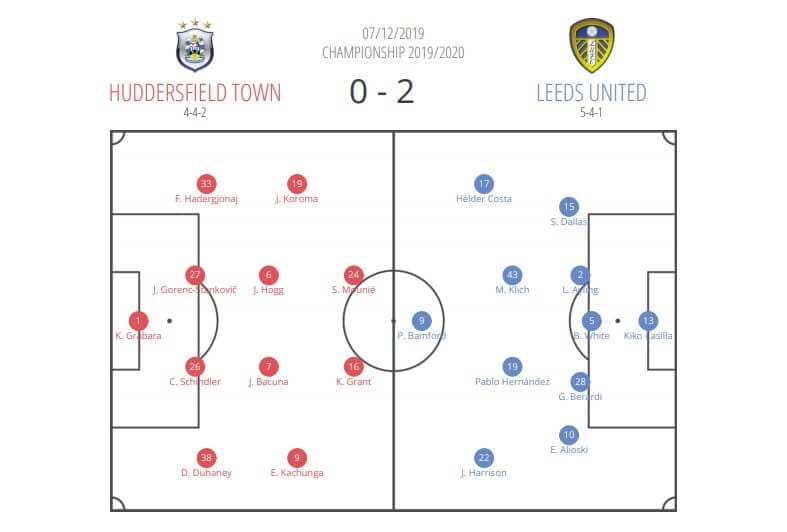
Danny Cowley made a total of three changes to his team. Steve Mounié came in for the injured Frazier Campbell, Josh Koroma took Lewis O’Brien’s place to go at left wing. And youth player Demeaco Duhaney got ahead of the infinitely more experienced Terence Kongolo, playing at right-back. Top scorer for the home side Karlan Grant would be looking to add to his tally of 11. Cowley’s options off the bench though were very limited with a number of youth players making the bench.
Bielsa has had to cope with a minor defensive crisis. Fan Favourite Kalvin Phillips picked up his fifth booking of the season against Boro and now serves a one-match ban. Unexpectedly, you could say, the legendary Argentinian head coach stated in his pre-match press conference that he would play Ben White in Phillips’ place as the single pivot. Adding insult to injury, Liam Cooper, the other centre-back was ruled out due to a minor calf strain, resulting in Luke Ayling covering and Ezgjan Alioski then went in Ayling’s place at full-back.
Huddersfield’s ferocious start
Recognising the importance to the fans the home side made their mark early as they had a purposeful tempo and intensity to their play and pressing.
Lining up in a traditional 4-4-2 the two strikers, Mounié and Grant, could match-up to the two Leeds centre-backs. This was a deliberate tactic from Cowley as Gaetano Berardi and Luke Ayling are both more comfortable at right-back.
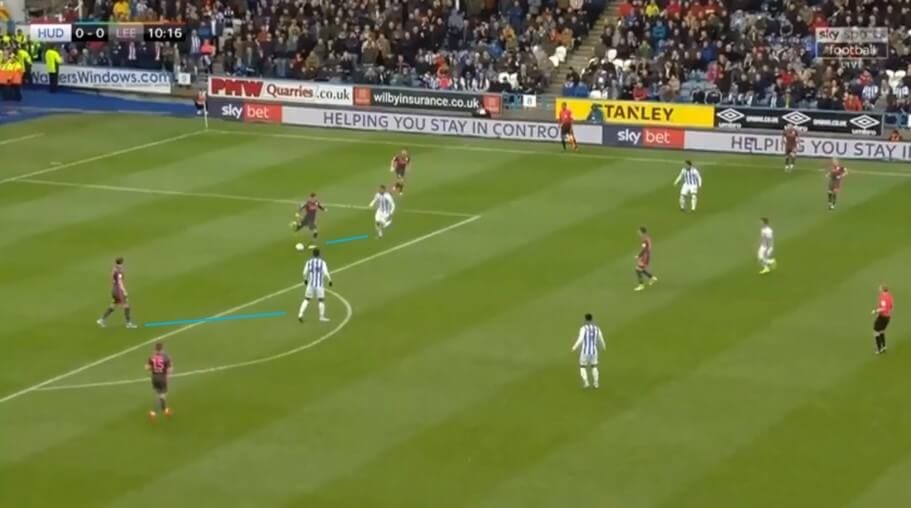
Bielsa has openly declared his preference when playing against two strikers is to have an additional defensive player nearby, in order to gain numerical superiority. This meant that White tended to drop deeper than you would expect from a pivot – something we’ll explore more later on – although this was not a very helpful tactic.
The pressing tactics in the first-half by Huddersfield were very effective in preventing simple ball progression – something Bielsa’s side are usually so competent and seamless at.
In this pressing system, the role of the two wingers and central midfielder Juninho Bacuna are important in understanding why the away side could not assert their typical fluid playing style on the game in the first 45. Koroma and Elias Kachunga would advance and narrow, whilst making sure their cover shadows were in an effective position. Bacuna has an inclination to go forward and contribute to offensive, proactive phases of play, and so he added an extra body to the press. These factors would mainly cause Leeds to go direct into Patrick Bamford. But this was not very successful – due to Bamford’s inability to hold the ball up and a lack of support when needed. Bamford won five of the 11 duels he had.
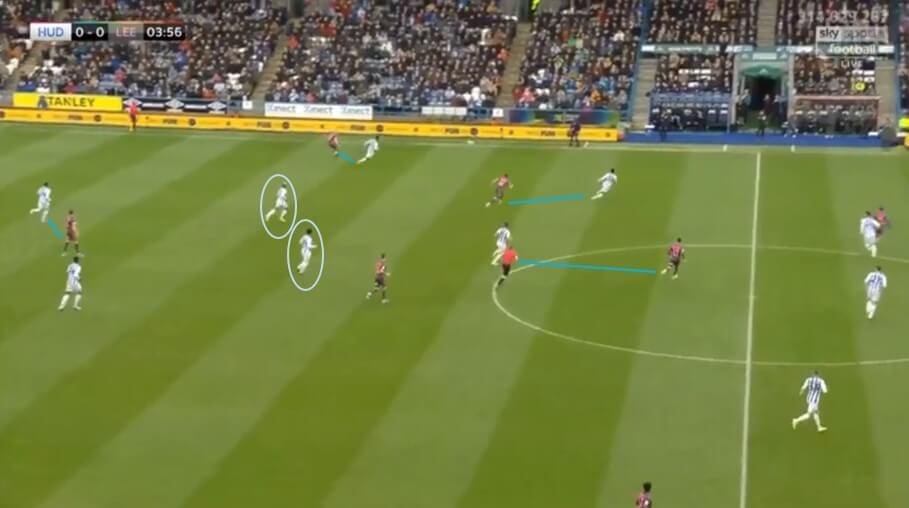
Much of the Huddersfield press was concentrated in the wide areas, where they could potentially expose an expansive Leeds side in transition and cross the ball in for two sizeable and physical strikers. Yet, the Terriers lack of technical quality – which was a common theme throughout – meant that they failed to capitalise on any turnovers in dangerous areas.
Huddersfield going direct
The inclusion of Mounié, replacing the injured Campbell, from the off gave a hint of what Cowley’s intention was. While the change was forced there is a big variation in height between the two. Mounié stands at 6” 3’ whereas Campbell’s height is 5” 8’. In addition to this, both Ayling and Berardi are both a relatively small 5” 10’. This is demonstrated by the fact Mounié won 12 out of a substantial 22 aerial duels contested.
This aerial dominance provided an outlet when Huddersfield had possession of the ball in deeper areas and were under pressure. Directness was also generally their attacking strategy. They would look to play off the front two or get the ball into wide areas and cross, getting a number of men into the box attack such crosses or the second ball. However, throughout the match, the team in blue and white completed merely six out of 20 crosses attempted.
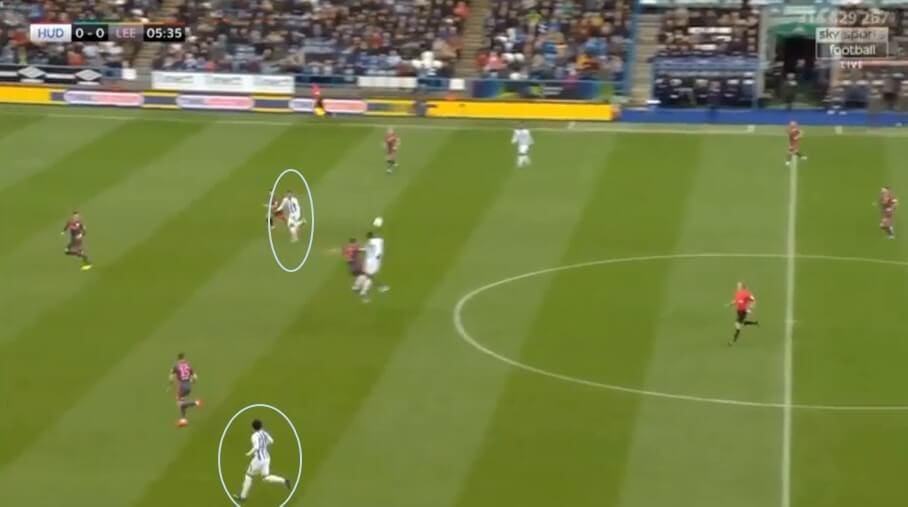
The Pivot problem
Since the beginning of last season, and Bielsa’s tenure, Phillips has emerged as a vital cog in the Bielsa system. He’s responsible for: creating space for attacking players to rotate into; maintaining that high intensity, attractive style that’s synonymous with Bielsa sides, and, acting as a defensive shield. White is a player who’s been outstanding – and perfect for the Bielsa philosophy – at centre-back this season. Therefore, it was surprising to see him moved from his regular position that he’s performed so brilliantly in.
Albeit playing as a CDM previously for Brighton academy sides, it was obvious White had a distinct lack of understanding to properly play a role so important to Leeds. Whether under instruction or not, his natural tendency was to slot into the defensive line. This saw an absence of an option in the usual position that Phillips takes up, and one less passing lane on an alternative, staggered line of play. Mateusz Klich, at times, dropped, but no proper presence for play to flow through remained a major problem for the Whites’ ball progression.
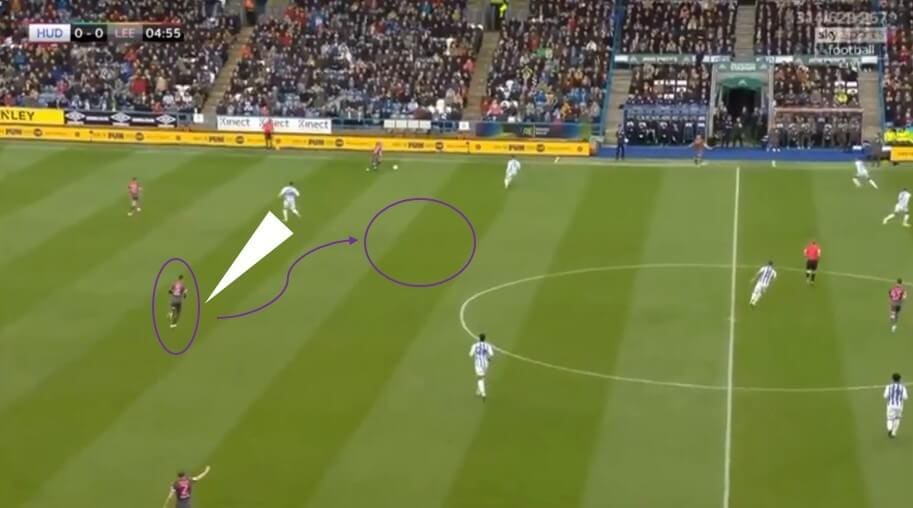
In the graphic above we see an example of the 22-year-old not possessing the quick thinking and positional awareness that’s so imperative for this role. He has not come across centrally quick enough and isn’t an option due to being blocked by Grant’s positioning. This forces Alioski to go long down the line, and not keep the ball on the ground steadily building and probing.
In this passing map below, White (No. 5) is not in the natural position you’d expect from a pivot. Instead, he’s split the pairing of Berardi and Ayling. Notice also how little the Brighton loanee is involved in passing combinations, something Phillips specialises in.
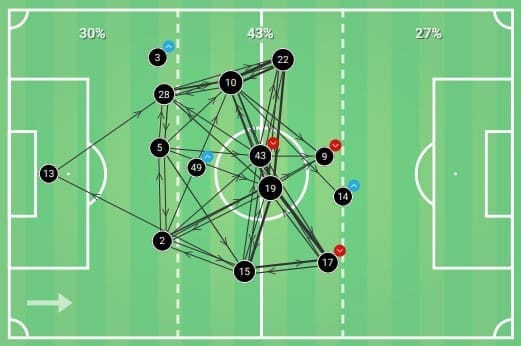
What Changed?
A key concept within this game was transitional play. Another important factor was the intensity and energy exerted by Huddersfield initially. These are inter-linked as they jointly combined to give Leeds the edge and get over the line.
After a moment of quality from Alioski gave Leeds the lead early in the second half the away side’s primary form of attack was playing on the counter.
Bacuna advancing gave support to Huddersfield attack but it did leave the experienced Jonathan Hogg to cover for him. At an age of 31 when caught out he can struggle to get back and he also has a problem with ill-discipline – so far, this EFL Championship campaign he’s accumulated eight yellow cards already. In the second half, Leeds exploited the space left between the defensive and midfield better. Through positional rotations like the one below where Pablo Hernández has dropped to provide support in the build-up phase, dragging Hogg with him. This then opens up space for White to drive into and then play out wide, shown in the second picture.
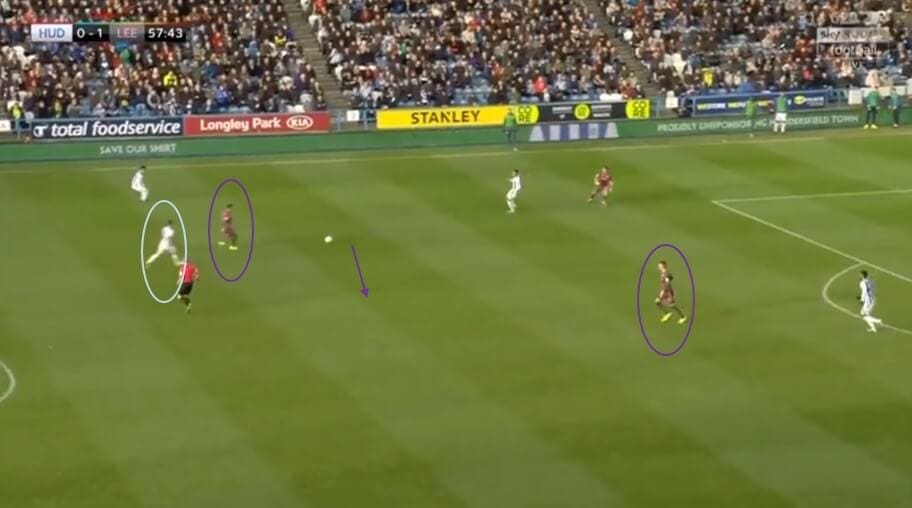
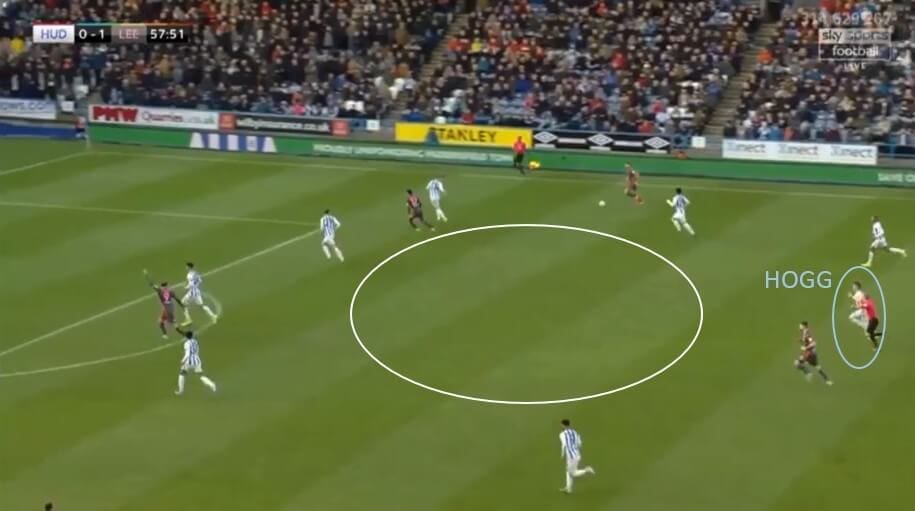
A similar situation occurs below. A series of rotations and interchanges see Hernández released centrally, after playing the ball back from a throw-in and then spinning on the blindside of Bacuna, but Hogg is also ignorant to the Spaniard’s run, so the playmaker now has a simple dribble and pass out wide available.
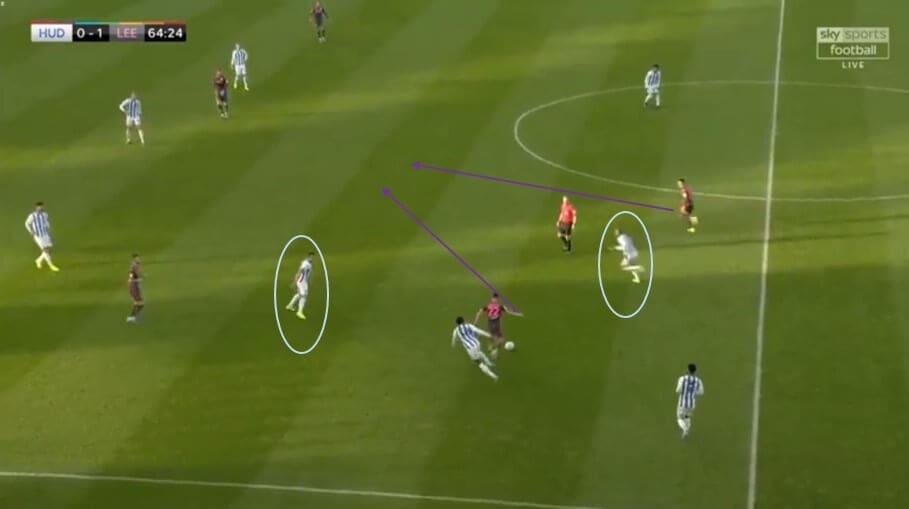
The Whites are incisive and dangerous when they have space to play into and if they were more clinical the scoreline would have been greater.
Conclusion
Leeds were very ineffective and unlike their usual selves in the first half. They lacked the fluidity that’s a common occurrence within their game model. When the game became stretched and their opponents tired they came into their own, demonstrating that devastating counter-attacking ability they possess.
Huddersfield’s poor finishing cost them here. Not scoring from 0.93 xG could be argued as feeble. Now sitting in 21st place and just two points above the drop zone that’ll have to improve to stave off the threat of relegation, as shown in this analysis.

If you love tactical analysis, then you’ll love the digital magazines from totalfootballanalysis.com – a guaranteed 100+ pages of pure tactical analysis covering topics from the Premier League, Serie A, La Liga, Bundesliga and many, many more. Buy your copy of the December issue for just ₤4.99 here






Comments